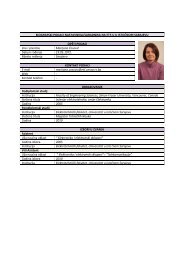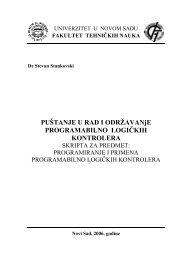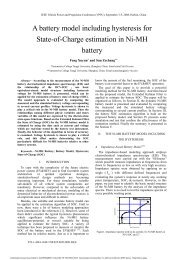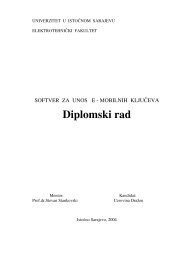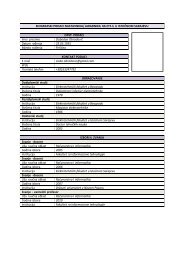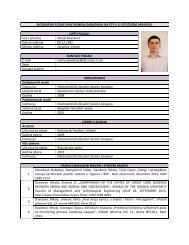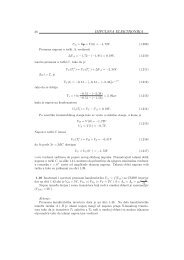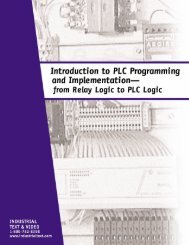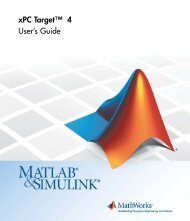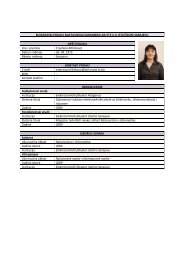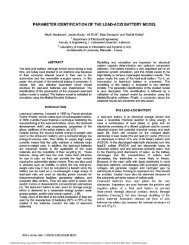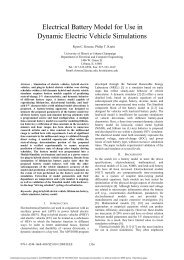New dynamical models of lead-acid batteries - Power Systems, IEEE ...
New dynamical models of lead-acid batteries - Power Systems, IEEE ...
New dynamical models of lead-acid batteries - Power Systems, IEEE ...
You also want an ePaper? Increase the reach of your titles
YUMPU automatically turns print PDFs into web optimized ePapers that Google loves.
CERAOLO: NEW DYNAMIC MODELS OF LEAD–ACID BATTERIES 1187<br />
A rapid comparison between (2) and the frequently adopted<br />
Peukert’s equation (cf. [3]):<br />
const<br />
shows that, although more complicated, (2) overcomes the chief<br />
inadequacies <strong>of</strong> Peukert’s equation, i.e., the lack <strong>of</strong> consideration<br />
<strong>of</strong> the temperature, and the fact that in correspondence to<br />
low currents it predicts capacities much larger than those experimentally<br />
obtainable (up to infinite capacity at zero current).<br />
Equations (1) and (2) have been declared valid when electrolyte<br />
temperature and discharge current are constant.<br />
During transients it can be postulated that they are still valid<br />
given that instead <strong>of</strong> the real battery current a filtered value<br />
<strong>of</strong> this current is used.<br />
This hypothesis has been experimentally confirmed, and is<br />
assumed in this paper; in particular, good results are obtained<br />
taking where is the current flowing in one <strong>of</strong><br />
the resistors (the actual depends on the particular model<br />
considered), and it is , .<br />
When simulating the battery using this model, the capacity<br />
must be on-line adapted to the computed actual electrolyte temperature<br />
and average current: .<br />
A per unit measure <strong>of</strong> the level <strong>of</strong> the discharge <strong>of</strong> a battery<br />
has to correlate the charge that has been actually extracted<br />
from the battery starting from a battery completely full with the<br />
charge that can be extracted under given, standard conditions.<br />
In the <strong>models</strong> proposed in this paper two different numbers<br />
are sued to quantify the level <strong>of</strong> discharge <strong>of</strong> the battery:<br />
• state-<strong>of</strong>-charge<br />
• depth-<strong>of</strong>-charge<br />
where (supposed that when the<br />
battery is completely full).<br />
The physical meaning <strong>of</strong> and is quite simple:<br />
while the first one is an indicator <strong>of</strong> how full is a battery with<br />
reference to the maximum capacity the battery is able to deliver<br />
at the given temperature , the second one is an indicator <strong>of</strong> how<br />
full is the battery with reference to the actual discharge regime<br />
(i.e., the value <strong>of</strong> the constant discharge current , or, in case <strong>of</strong><br />
variable current the value <strong>of</strong> ).<br />
1) Electrolyte Temperature: It has been stated in Section II<br />
that the elements <strong>of</strong> the electric equivalents <strong>of</strong> electrochemical<br />
have to be computed for each electrolyte temperature. In fact,<br />
since the <strong>batteries</strong> are extensive components, each electrolyte<br />
point has a temperature <strong>of</strong> its own.<br />
However, to avoid this additional complexity, in the proposed<br />
model a unique value has been assumed, that is somehow an<br />
equivalent <strong>of</strong> the whole temperature map.<br />
Then, the dynamic equation that allows the electrolyte temperature<br />
computation is, simply:<br />
or, equivalently:<br />
Fig. 5.<br />
Equivalent electric network used for the third-order battery model.<br />
where:<br />
is the battery thermal capacitance<br />
is the electrolyte temperature<br />
is thermal resistance between the battery and its<br />
environment<br />
is the ambient temperature i.e., the temperature <strong>of</strong> the<br />
environment (normally air) surrounding the battery<br />
is source thermal power, i.e., the heat that is generated<br />
internally in the battery<br />
is the variable <strong>of</strong> the Laplace transform.<br />
When a battery module contains more than one element, a<br />
unique temperature for the electrolyte <strong>of</strong> the whole module can<br />
be utilized.<br />
C. Model Parameters<br />
It has been previously stated that the battery can be simulated<br />
by electric networks <strong>of</strong> the types shown in Fig. 4, in which the<br />
numerical values <strong>of</strong> the elements <strong>of</strong> these networks have to be<br />
computed for each value <strong>of</strong> electrolyte temperature and state-<strong>of</strong>charge.<br />
Obviously, in practice they can computed only for discrete<br />
values <strong>of</strong> these two quantities, and the values between are<br />
to be obtained by means <strong>of</strong> some form <strong>of</strong> interpolation.<br />
To simplify the task, a large amount <strong>of</strong> <strong>lead</strong>–<strong>acid</strong> battery data<br />
have been processed to find analytical functions able to reproduce<br />
the typical behavior <strong>of</strong> the elements <strong>of</strong> Fig. 4, (i.e. e.m.f.’s,<br />
’s, ’s) as function <strong>of</strong> and/or , and . These functions<br />
contain some numerical coefficients (The “model parameters”)<br />
to be computed based on experimental battery tests.<br />
In the following paragraph, these analytical functions are reported,<br />
with reference to one <strong>of</strong> the possible <strong>models</strong> that can be<br />
built based on the electric equivalent <strong>of</strong> Section III-A, i.e., that<br />
in which two – blocks are present.<br />
D. Third-Order Model Formulation<br />
Among the several possibilities given by the modeling techniques<br />
described in the previous paragraphs one <strong>of</strong> the most suitable<br />
for general-purpose modeling is constituted by:<br />
• an electric equivalent with two – blocks and an algebraic<br />
parasitic branch (Fig. 5);<br />
• algorithms for computing the state <strong>of</strong> charge and internal<br />
(electrolyte) temperature<br />
• equations for computation <strong>of</strong> the elements <strong>of</strong> the equivalent<br />
electric network as function <strong>of</strong> state <strong>of</strong> charge and<br />
temperature.<br />
Authorized licensed use limited to: GOVERNMENT COLLEGE OF TECHNOLOGY. Downloaded on June 22,2010 at 10:31:37 UTC from <strong>IEEE</strong> Xplore. Restrictions apply.



